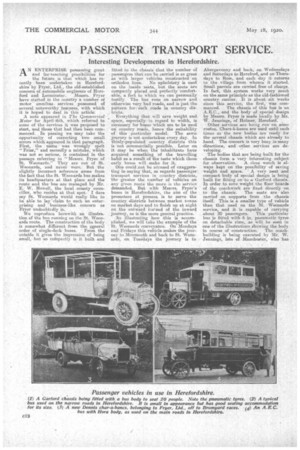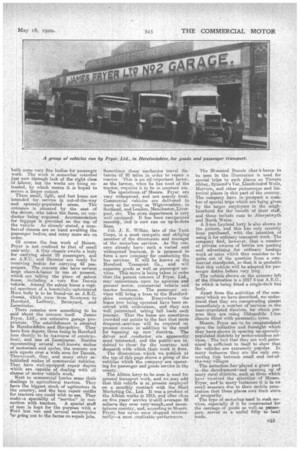RURAL PASSENGER TRANSPORT SERVICE.
Page 12

Page 13

If you've noticed an error in this article please click here to report it so we can fix it.
Interesting Developments in Herefordshire.
A ENTERPRISE possessing great and far-reaching possibilities for the future is that which has recently been undertaken in Herefordshire by Fryer, Ltd., the old-established concern of automobile engineers of Here ford and Leominster. Messrs. Fryer have started in the country a number of motor omnibus, services possessed of several noteworthy features, with which it is hoped to deal in this article.
A note appeared in The commercial Motor for April L6th, which referred to some of the services it was proposed to start, and those that had then been commenced. In passing we may take the opportunity of correcting two small errors which appeared in that paragraph. First, the name was wrongly spelt " Friar," and secondly a mistake, which was not so serious, is contained, in the passage referring to "Messrs. Fryer of St. Weonards.' They are not of St. Wermards, and never were, But the slightly incorrect 3eference arose from the fact that. the St. -Weimar* bus makes its headquarters at that place and the route and the bus aremanaged by Mr. E. W. Howell, the local county councillor, who resides at that spot. I dare . say St. Weonards would really like to be able to lay 'claini to such an enterprising and business-like concern as Fryer undoubtedly is.
We reproduce herewith an illustration of the bus running on the St. Weonards route, The construction of the body is somewhat different from the, genesal
order of single-deck buses. From the outside it gives the impression of being small, but -so coMpactly is it built and
fitted to the chassis that the number of passengers that can be carried is as great as with larger vehicles constructed on orthodox lines. No upholstery is used on the inside seats, . but the seats are compactly placed and perfectly comfortable, a fact to which we can personally testify. The bus runs on narrow and otherwise very bad roads, and is just the pattern for. such roads in country dis tricts. • Everything that will save weight and space, especially, in regard to width, is necessary for buses which are to be used on country roads, hence the suitability of this particular model. The same journey is not undertaken every day. In thinly-populated country districts this is not commercially possible.. Later on it may be when the inhabitants ha.ire acquired something of the travelling habit as a result of the taste which these early buses will make for it.
One could not be accused of exaggerating irrsaying that, as regards passenger transport services in country districts, the greater the number of vehicles on any given route the more is the service demanded. But with Messrs. Fryer's buses in Herefordshire, the aim of the promoters at present is to serve the country districts between market towns on market days and to finish up at night on the outward instead of the inward journey, as is the more general practice. 'As illustrating how :this is accomplished, we will take the example of the St. \Veonards conveyance. On Mondays and Fridays this vehicle makes the journey to Monmouth and back to St. Weonards, on TueSdays the journey is to Abergavenny and back, on Wednesdays and Saturdays to Hereford, and on Thursdays to Ross, and each day it returns to the village from whence it started. Small parcels are carried free of charge. In fact, this system works very much on the same principle as the old-fashioned country carrier. It is about -six weeks since this service, the first, was commenced. The chassis of this bas is an A.E.C., and the body of special design by Messrs. Fryer is made locally by Mr. W. Jennings, of Holmer, Hereford.
Other services are being run on some routes. Chars:a-bancs are used until such times as the new bodies are ready for the several chassis which are already to hand. The concern is very busy in many directions, and other services are developing.
The bodies that are being built for the chassis form a very interesting subject
for observation. A close watch is always kept on the possibility of saving weight and space. A very neat and compact body of special design is being built for fitting on to a Garbed chassis. In order to save weight the floor boards of the coachwork are fixed directly on
to the chassis. The, seats are also carried on supports from the chassis itself. This is a smaller type of vehicle than that used on the St. Weimar& service, and it is capable of carrying
about 20 passengers. This particular bus is fitted with 6 in. pneumatic tyres on detachable rims, as will be seen in one of the illustrations showing the body in course of construction. The coachbuilding is being executed by Mr. W. Jennings, late of Manchester, who has built some very fine bodies for passenger work. The work is somewhat retarded just now through lack of the right daze of labour, but the works are being extended, by which means it is hoped to secure a larger output.
These small, light, and fast buses are intended for service in out-of-the-way and sparsely-populated areas. The entrance is situated by the seat of the driver, who takes the fares, no conductor being required. Accommodation far luggage ia provided on the top of the vehicle. As already stated, a number:of chassis are on hand awaiting the passenger bodies, and many more are on order.
Of course the bus work of Messrs. Fryer is not confined to that of small cars-only. A Guy chassis awaits a body for carrying about 25 passengers, and an A.E.O. and Daimler are ready for receiving bodies for -carrying 43 passengers. The concern also have several large ehars-a-bancs in Use at present, which are taking the place of saloon buses, including a very fine Dennis vehicle. Among the saloon buses a. capital specimen of a beautifully-eupholetared Bora body is to be foundum an A.E.C. ehaseie, which Tuns from Newtown to Hereford, Ledbary, Brornyarcl, and Leominster.
There remains now something to be said about the concern itself. James Fryer, Ltd. are extensive garage proprietors. 'The establishment is situated in Herefordshire and _Shropshire. They have four depots, three being in Hereford (one shortly to be inecourse of construction), and one at Leominster. Besides representing several well-known makes of motorcars and cycles, the concern are sole agents over a wide area for Dennis, Thornveroft, Guy, and many other established makes of commercial vehicles. They have well-equipped repair depots which are capable of dealing with all classes of motor vehicle work.
Next to commercial lorries come their dealings in agricultural tractors. They have the biggest stock of agrimotors in the country, and the best repair outfits for tractors nne could wish to see. They makeea speciality of "service" in connection with tractors. A special staff of men is kept for the purpose with a Ford box van and several motorcycles or going out to the farms on repair jobs.
Sometimes these mechanics travel dietances of 80 miles in order to repair a tractor. This is an all-important factor, as the farmer, when he has need of the fleeter, requires it to be in constant use, The operations:or-Messrs. Fryer are very widespread, and not merely local. Commercial vehicles are delivered to Users as far away as Wigtownshire, in Scotland, and London, Manchester, Liverpool, etc. The store department is very well equipped. ft has been reorganised recently, and is now run on up-to-date lines.
Col. J. E. Wilkes, late of the Tank Corps is a most energetic and obliging member of the directorate and manager of the motorbus services. As 'the concern already have such a varied and widespread business, it is proposed to form a new company for conducting the bus services. It will be known as the Hereford Transport Co., and will organize goods as well as passenger services. This move is being taken in order that the parent aro:teem of Fryer, Ltd., may concentrate upon its agencies and general motor, commercial vehicle and tractor business. The passenger services will bring a boon to the Herefordshire countryside. Everywhere the buses now being operated have been received with 'enthusiasm, and they are well patronized. taking full loads each journey. That the buses are sometimes crowded out points to the fact that more frequent eeervices will be required on present routes in addition to the need for foperting up new districts. The driver and conductor are apparently. most interested, and the public are indebted to them; for the courtesy and despatch with which their work is done.
The illustration ;which we. publish at the top of this page sheive a group of the yehipIes which the company areoperating for passenger and 'goods service in the county... The Albion, lorry to-be seen is used for general transport work, and.we,may add that this vehicle is at,peesent employed on a monthly contract with the Shell Marketing Co., Ltd It was a product of the Albion works in 1915, and after close on-five years' service itestill• averages 50 milesea day over very'rough,and mountainous country, and, according to Mesers, Fryer; has never once slopped involuntarily—a most creditable 'performance; The 30-seated Dennis char-h-bance to be seen in the illustration is used for special trips to such places as Tintern Abbey, Symond'e Vat, Llandrindoci Wells., Malvern, and other picturesque and historical places in this part of the country. The company have in' prospect a number of special trips which are 'being given by the larger employers in the neighbourhood for the. benefit of -their staff, and these include runs to Aberystwyth and North Wales.
-A 3-ton. Leyland lorry is also shown in the picture, and this has only recently been purchased, with the intention of using it for ordinary transport work..The company find however, that a number of private oieners of lorries are quoting and advertising for ordinary haulage work at rates which they consider to be quite out of the question from a commercial .efa.ndpoint, so that it is probable that this vehicle will be adapted for pas senger duties before very long. • •
The vehicle shown on the extreme left of the illustration is a 1917 4-ton A.E.C., to which is being fitted a single-deck bus body.
Apart from the activities of the company which we have described, we understand that they are inaugurating eine:1st inunediately a number of 'services in the leastfpopulated districts, for which purpose they are using Oldsmobile .1-ton chassis fitted with pneumatic tyres.
Messrs. Fryer are' to be congratulated upon the initiative and foresight which they have shown in opening up:sparselypopulated districts by motor-omnibus services. The fact that they are well patronized'is sufficient in itself to show that the vehicles are extremely popular. In many instances they are the only connecting link between small and out-ofthe-way villages The motorbus.has'played a great part in 'the developmenteand opening up. of many rare districts, such as those which have received the attention of Mesas. Fryer, ancl'in many instances it is in no small measure due to their mobile penetration that these places owe their state of prosperity.
The -type of motorbus used in such services, especially if it be constructed for the carnage of goods as well as passengers, serves as a useful fillip to local trade.




























